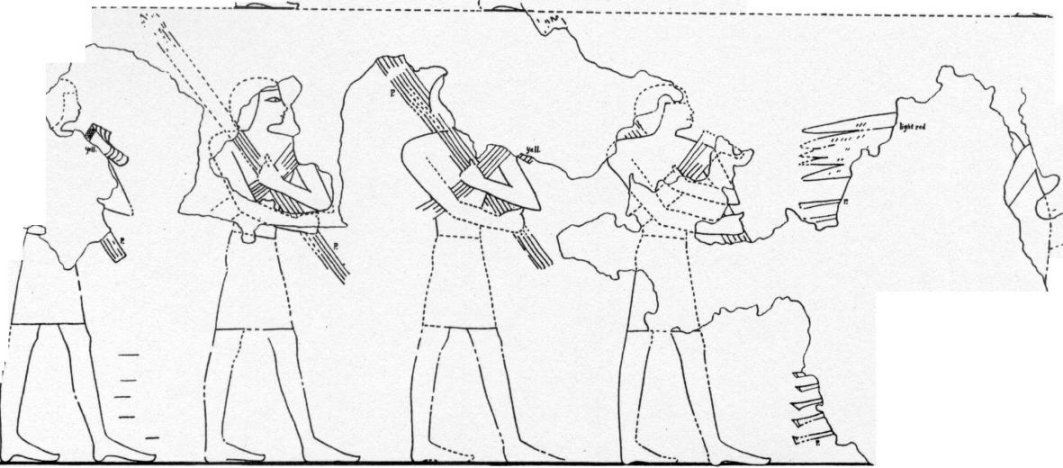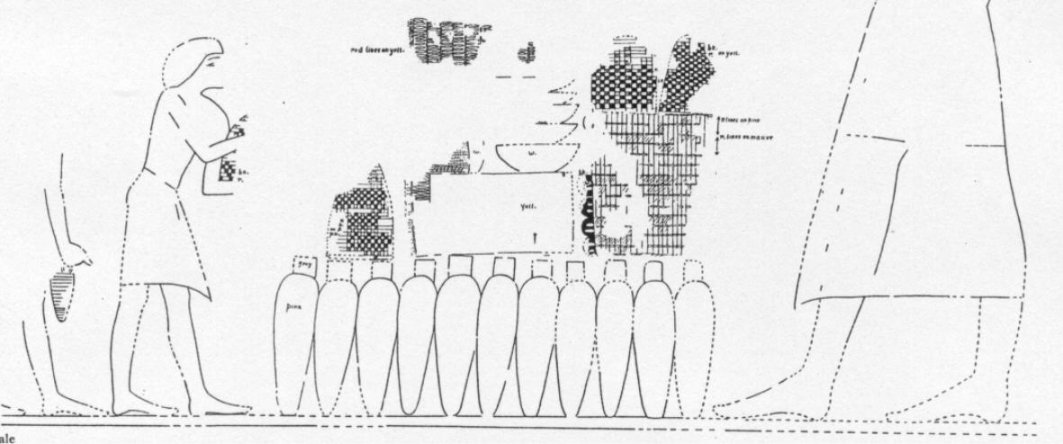 |
Antef |
last update:
26.03.2008
|
Historical Data
| Name |
Title |
|
Origin |
Tomb |
Antef
Jntf |
Hereditary Prince, Count, Wearer of the Royal
Seal, Sole Companion (of the King), Chief of the Oases, Nomarch, Great Herald of the King,
Director of the Granary |
|
? |
TT155
Dra Abu el-Naga |
| Wife: name not known |
|
|
|
|
| Parents |
|
|
|
|
| Father: unknown |
|
|
|
|
| Mother: unknown |
|
|
|
|
| Brother(s): |
|
|
|
|
| Ahmose |
royal scribe, overseer of horns, hoofs,
feathers, and scales, reckoner of bread of Upper and Lower Egypt |
|
|
|
| Sister(s): |
|
|
|
|
| none known |
|
|
|
|
| Children: |
|
|
|
|
| Sons: |
Teti (Scribe), Amenw... |
|
|
|
|
The tomb TT155 of the Great Herald of the Queen, Antef, is located in the
northern part of Dra Abu el-Naga. The tomb which is today a complete ruin
must have been an imposing monument in antiquity. As in many other tombs
of this epoch the first room has a row of pillars instead of a solid front
wall (see floor plan below). Behind the first room there is a long passage
and then another chamber. In the rear wall of this chamber there is a
large niche for the statues.
The tomb was hewn directly into the rock, the walls were covered with a
lime plaster. There was no stonework whatever, unless on the jambs to the
niche.
Today, only the lower parts of the pillars are preserved and the rear
wall of the first room which was exposed for many years is worn or fallen
away except at the bottom.
|

|
Floor plan of tomb TT155, from Säve-Söderberg (1957)
|
Not very much had been preserved of the decoration of the pillars, a
description of the less imposing remains is given by Säve-Söderberg
(1957).
On the side walls of the first room two stela were made in
plaster, of the southern one nothing has been preserved, of the northern
(above the position XIXF) only the lower part of a false-door stela with
"sem"-priests at each side has survived. The false-door has a
step in front and five recessed jambs on each side on which parts of the
name of Antef have survived. The fact that these figures and the name of
Amun on one of the pillars have survived the Amarna-period suggest that
the tomb was inaccessible or already badly damaged before that time.
Further fragments show conventional offering
formula and one the title of Antef (wHm tpj n
nswt = First or Great Herald of the King).
|
| The scenes that decorate the left side of the rear wall
of the hall (Position XI - XIII) show aspects of his official life which
are also mentioned in his autobiography on the Louvre stela. The
Great Herald had to report to the king, introduce people to the king, to
make known royal commands, and to act as a Quartermaster-General during
the campaigns. Furthermore, the Great Herald was also the one who
"reckons the levies (of officials, mayors, and the heads of the
districts) - i.e. he was the "first tax collector". Antef's
occupation with the taxation in Egypt is shown among others of the
following drawings by Säve-Söderberg (1957) showing the left rear wall
of the hall. One of the scenes show him together with his brother,
Ahmose (standing in front of him), and another one again with Ahmose and
his beloved son, the royal scribe, Teti. Further scenes show Antef
observing foreigners bringing tribute, among them people from "Kheftiu"
(= Crete).
|
|
The right part of the rear wall of the hall (position XIV, XV) shows Antef enjoying
"sports" in the marshlands. He is shown spearing fishes, hunting
the water-fowl with a boomerang (upper part of the following drawings) and
harpooning a hippopotamus (lower part). The decorations were apparently
rather damaged already at the times of Säve-Söderberg, thus, he himself
must rely in his description of the tomb (1957) on illustrations from
earlier visitors.
|
|
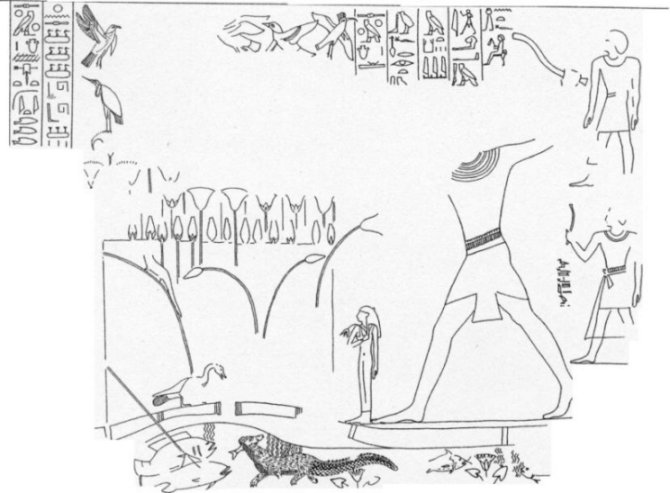
|
The drawings shows Antef, standing on the right side of
the boat, hunting the water-fowl with a boomerang, left in front of
him, at the bow most likely his wife is depicted holding a lotus
flower. Behind him are two attendants, one of them bringing another
boomerang is "his beloved son, Amenw....".
Below the bow a crocodile is shown just swallowing a fish - this
is a very rarely depicted in such scenes (e.g. see Tomb of Menna). |
|
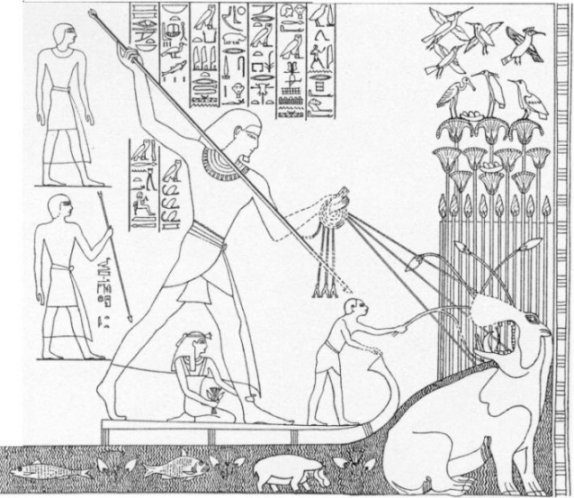
|
| Also the scene showing Antef harpooning a hippopotamus
is very rare in Theban tombs. Säve-Söderberg has published a
detailed analysis about the hippopotamus hunting which was found in 10
private Theban tombs only (1957). In his opinion these representations
are derived from Old Kingdom prototypes where the king had been the
main actor. Harpooning the hippopotamus represents the victory of the
king and the god (which is the same in this case) over all evil power
symbolized by the hippopotamus. All Theban tombs in which this scene
occurs date from the reigns of Hatshepsut, Thutmosis III, and one
possibly from the beginning of the reign of Amenhotep II. |
|
The passage to the inner room shows the deceased adoring the Horus-name,
remains of the funeral procession with purification of the mummy, remains
of hunting scenes, and the bringing of cattle (?), birds, and other
products of the marshlands.
|
|
Among the decorations of the passage two representations are of special
interest. The decorations (see following drawing; position XVIIIA und B)
show Antef facing outwards and standing in front of a kind of
"pavilion". The lower part of this "pavilion" is
decorated with the "Union of the Two Lands" whereby on the
northern thickness (XVIIIA) two Asiatics and on the southern two Nubians
are fettered to the sign (see below).
|
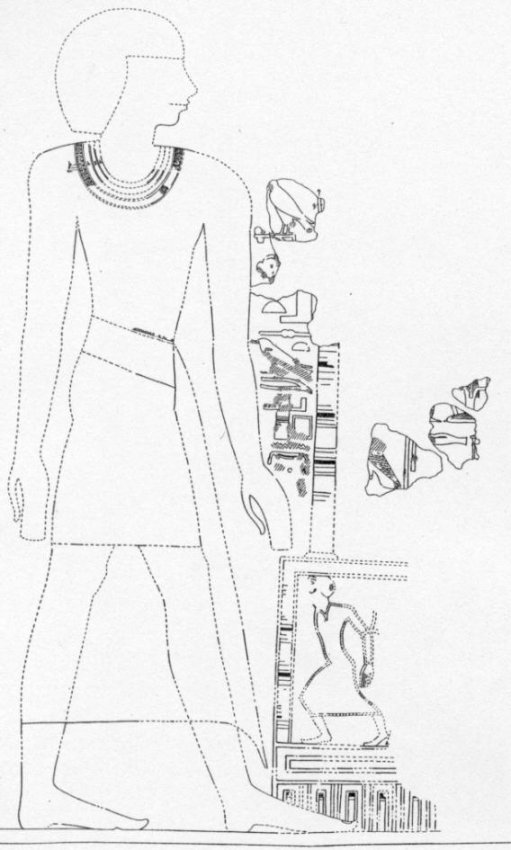
|
There was a text in front of Antef partly preserved that reads: "Horus
on her great throne in the Palace of Gold". Obviously, the
"pavilion" has represented the "Palace of Gold" but of
more interest is that the ruler must have been Hatshepsut due to the
female suffix. This would imply that the work on the tomb of Antef was
started in the reign of Hatshepsut and probably finished under Thutmosis
III.
|
|
Practically nothing remains of the decoration of the inner room and the
chapel, a few fragments left in situ do not allow a relevant description.
Therefore, only a few hints to the fragments are given by Säve-Söderberg
or by Porter&Moss.
|
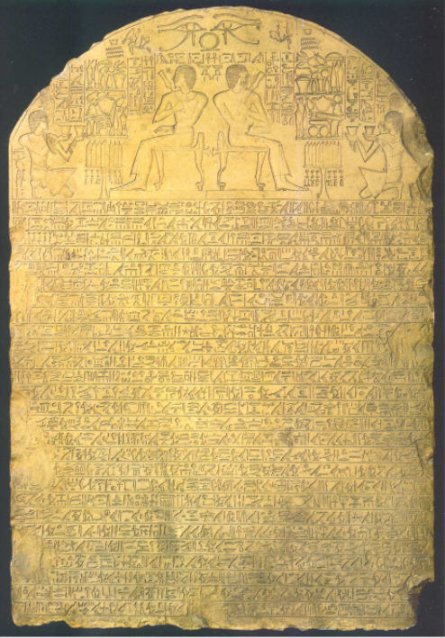
|
Stela of Antef from TT155, today in the Louvre, Object C26; Height: 125
cm, Width: 120 cm; it is not known where the stela was mounted in the tomb.
|
|
The top of the stela shows left the son, Teti, and right the brother,
Ahmose, both kneeling in front of the double presented deceased. A
long "Appeal to visitors" is followed by an autobiography that
confirms the titles and official positions mentioned inside the tomb.
|
|
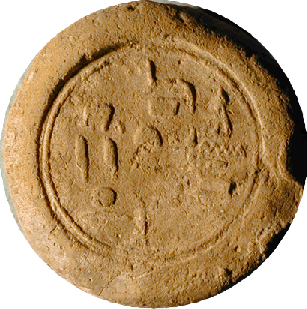
|
|
Funerary cone of Antef; Quelle; Petrie Museum, London, UC37602
|
|

